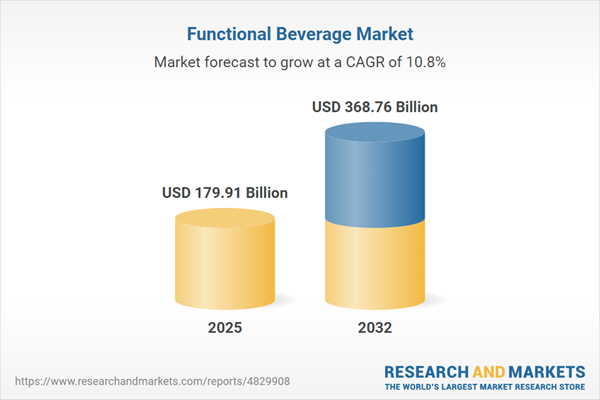Speak directly to the analyst to clarify any post sales queries you may have.
The functional beverage market continues to gain traction as health-conscious consumers and businesses alike seek innovative beverage solutions tailored to evolving lifestyles, regulatory demands, and sustainability expectations. Market players must align product development, operational agility, and consumer engagement to secure leadership in this dynamic industry.
Market Snapshot: Functional Beverage Market Growth Dynamics
The functional beverage market grew from USD 162.33 billion in 2024 to USD 179.91 billion in 2025. It is forecast to sustain growth at a compound annual growth rate (CAGR) of 10.80%, ultimately reaching USD 368.76 billion by 2032.
This expansion reflects increasing consumer interest in wellness-oriented drinks, where both efficacy and natural taste are prioritized. Competition is intensifying as global and emerging brands respond with science-backed products and transparent value propositions.Scope & Segmentation: Addressing Evolving Preferences and Regional Variations
- Product Types: Energy drinks (carbonated and non-carbonated), functional water (including alkaline, detox, electrolyte, and enhanced varieties), nutritional drinks (covering meal replacements, medical nutrition, and weight management formulations), plant-based beverages, probiotic drinks (non-dairy formats), ready-to-drink tea and coffee, and sports drinks (hypertonic, hypotonic, isotonic).
- Ingredients: Amino acids such as BCAAs and L-glutamine, antioxidant blends like green tea extract and resveratrol, caffeine (both natural and synthetic sources), electrolytes (magnesium, potassium, sodium), probiotics including Bifidobacterium and Lactobacillus strains, and vitamins & minerals (such as calcium, magnesium, B complex, vitamin C, and vitamin D).
- Packaging Types: Bottles, cans, cartons, pouches, and sachets, each offering varying degrees of convenience and sustainability features.
- Distribution Channels: Offline retail, online retail through direct-to-consumer platforms, and e-commerce marketplaces.
- End User Groups: Adults, athletes, children, and seniors, reflecting a broad and diverse target audience with specialized nutritional and functional needs.
- Regions: Americas (United States, Canada, Mexico, Brazil, Argentina, Chile, Colombia, Peru), Europe, Middle East & Africa (including United Kingdom, Germany, France, Gulf Cooperation Council countries, South Africa, and Nigeria), and Asia-Pacific (China, India, Japan, Australia, South Korea, and Southeast Asian countries).
- Key Industry Players: The Coca-Cola Company, PepsiCo, Nestlé, Red Bull, Monster Beverage Corporation, Danone, Keurig Dr Pepper, Suntory Beverage & Food, Asahi Group Holdings, and Yakult Honsha.
Key Takeaways: Strategic Insights for Senior Decision-Makers
- Consumers increasingly demand transparency and science-backed functional benefits, requiring brands to validate ingredient efficacy and clearly communicate value.
- Personalized nutrition is shaping new product development, with data-driven platforms supporting individualized recommendations and subscription-based delivery models.
- Regional dynamics play a crucial role, as preferences for clean labels, eco-friendly packaging, and specific functional profiles vary considerably from North America to Asia-Pacific.
- Supply chain resilience has become a differentiator, with organizations exploring nearshoring, alternative ingredient sourcing, and collaborative digital management tools to mitigate disruption.
- Strategic partnerships with biotech firms and research organizations accelerate ingredient innovation and support rapid prototyping of novel functional beverages.
Tariff Impact: United States 2025 Trade Policy Considerations
The introduction of revised United States tariffs in 2025 has significantly influenced cross-border trade, prompting companies to adjust sourcing strategies and explore new supplier geographies. Fragmented supply chains have led businesses to implement advanced inventory systems, long-term contracts, and domestic formulation alternatives to maintain competitiveness. Regional trade agreements and tariff rebates are increasingly in focus to manage regulatory risk and operational costs.
Methodology & Data Sources
This research is built on primary interviews with industry executives, suppliers, contract manufacturers, and regulators, complemented by secondary analysis of peer-reviewed literature, trade reports, and proprietary databases. Quantitative modeling supports scenario planning, while web-based sentiment and trend analysis provide current market insights.
Why This Report Matters for Stakeholders
- Enables strategic decisions by providing a detailed understanding of growth drivers, market trends, and actionable opportunities in the functional beverage industry.
- Supports regulatory and operational planning by mapping key regions, customer segments, and supply chain developments relevant to senior leadership.
- Advises on the alignment of product portfolios, digital initiatives, and sustainability imperatives critical to gaining and maintaining a competitive edge.
Conclusion
The functional beverage market's trajectory is driven by consumer demand for validated health benefits, evolving technologies, and shifting regulatory landscapes. Senior decision-makers equipped with robust data and actionable insights will be prepared to capture value and lead within this rapidly developing sector.
Additional Product Information:
- Purchase of this report includes 1 year online access with quarterly updates.
- This report can be updated on request. Please contact our Customer Experience team using the Ask a Question widget on our website.
Table of Contents
3. Executive Summary
4. Market Overview
7. Cumulative Impact of Artificial Intelligence 2025
Companies Mentioned
The companies profiled in this Functional Beverage market report include:- The Coca-Cola Company
- PepsiCo, Inc.
- Nestlé S.A.
- Red Bull GmbH
- Monster Beverage Corporation
- Danone S.A.
- Keurig Dr Pepper Inc.
- Suntory Beverage & Food Limited
- Asahi Group Holdings, Ltd.
- Yakult Honsha Co., Ltd.
Table Information
| Report Attribute | Details |
|---|---|
| No. of Pages | 180 |
| Published | October 2025 |
| Forecast Period | 2025 - 2032 |
| Estimated Market Value ( USD | $ 179.91 Billion |
| Forecasted Market Value ( USD | $ 368.76 Billion |
| Compound Annual Growth Rate | 10.8% |
| Regions Covered | Global |
| No. of Companies Mentioned | 11 |









